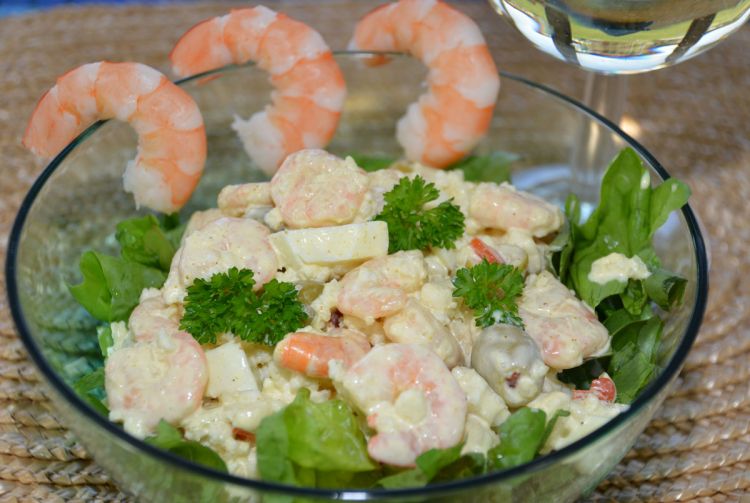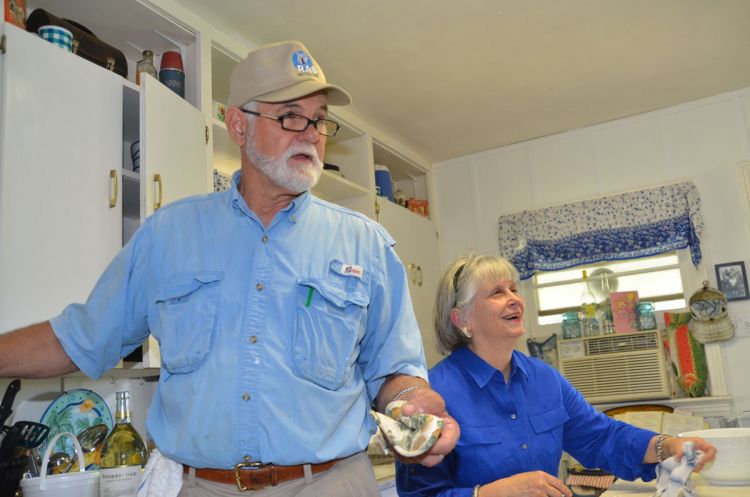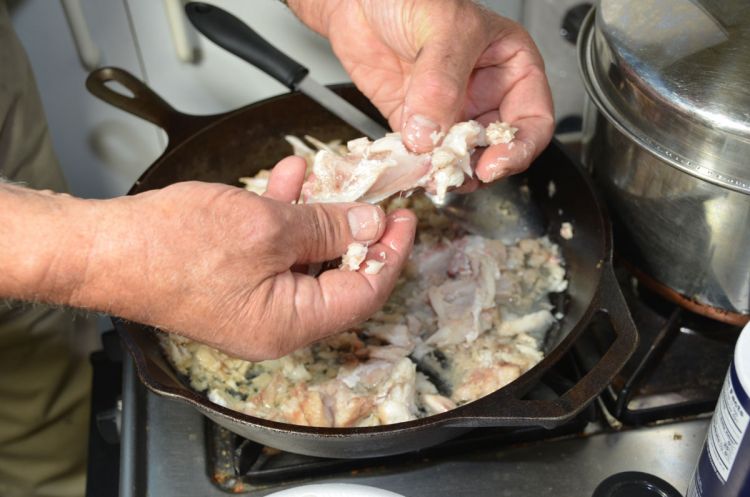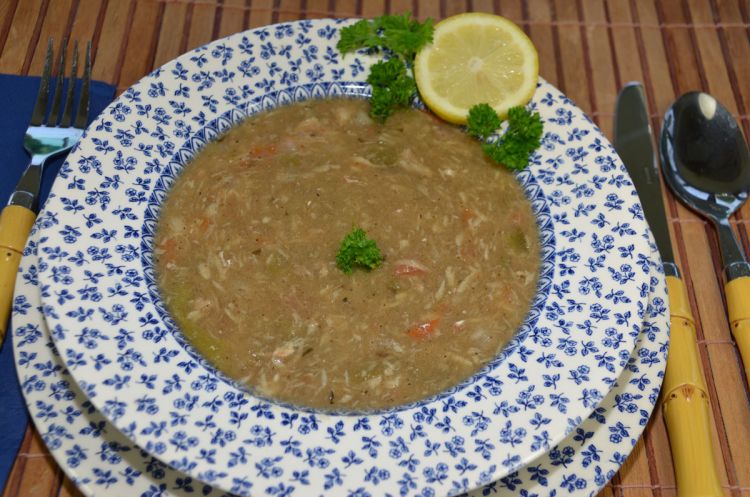 These cooks can do both
These cooks can do both
Wilmer and Betsy Mills live in a rambling, early 20th century Southern farm home that breathes history from every board of which it was built.
Set in an active hay and pasture grass seed farm in The Plains near Zachary, the house is surrounded by Wilmer’s fruit trees and vegetable gardens.
The gracious couple’s recipes reflect their different personalities and styles.
Betsy’s Curried Shrimp Salad is solid and sensible (as well as delicious). Wilmer’s Fish Head Soup (also scrumptious) comes straight out of the jungles of Brazil, where the couple spent eight years as agricultural missionaries.
We met the couple through mutual friend Barbara Picard and cooked with them at their Grand Isle fishing camp, what Betsy calls, “our escape from reality.”
The setting was a natural. The island is surrounded by seafood.
Betsy has an artistic side. She paints still lifes with oils and pallet knife, and does portraits with pencil, charcoal and pastels. She weaves and has several looms, making textiles for clothing, tablecloths and place mats.
Although she loves to read cookbooks and calls Saveur magazine the National Geographic of cooking, she said cooking is a necessity rather than a hobby. She called their cooking “very country,” which they can easily do because of Wilmer.

The more flamboyant Wilmer loves to cook and never follows recipes, but more importantly, he is a fierce gardener and forager. He grows three year-round vegetable gardens (including artichokes and asparagus), five varieties of figs, two types of persimmons, grapefruit, naval oranges, tangerines, Meyer lemons, key limes, both sweet and sour kumquats, loquats, plums, blueberries and pomegranates.
He picks blackberries and dewberries from the farm’s fence lines, and muscadines, possum grapes, wild plums and crab apples from the woods.
He grows ribbon sugarcane and makes his own old-fashioned open-kettle syrup. He brought the cane mill and a hammer mill back from Brazil.
He also raises Otraheite and rose bamboo “chewin’ cane” that he described as being easy on the gums.
He makes his own grits on the hammer mill, producing corn meal and “whole kernel grits, not the kind that is sifted and blown.”
For meat, he traps wild hogs and hunts deer on their property. They no longer buy beef.
He smokes and grills, and Betsy calls his jerky “really good.”
He owns and regularly uses three wood stoves (one at home, and one each at his camps on Thompson Creek and Linwood Plantation).
To say the least, Wilmer and Betsy are an interesting couple.
Curried Shrimp Salad
Betsy Mills said she first ate this dish at friends Andy and Ellie Silman’s home.
“It was just delicious,” Mills said. “She referred me to a Junior League cookbook from Jackson, Miss., for the recipe. I bought the book.
“If I am going to do a shrimp salad, this is the one I make. It is a little labor-intensive — lots of ingredients and (it) has a sauce. I cook it for special occasions. You can beef it up for a dinner salad by adding artichokes, but we mainly use it as a side salad.
“You can cut the cauliflower as fine or coarse as you want it. People say, ‘Oh, what is in this salad?’ It is the cauliflower.”
INGREDIENTS:
- 1 cup mayonnaise
- 1 tsp. horseradish mustard
- 2 tsp. lemon juice
- 1 tsp. grated onion
- 1/2 tsp. curry powder
- Dash Worcestershire sauce
- Salt to taste
- 2 oz. stuffed green olives, drained and chopped
- 1 cup cooked peeled shrimp (whole small or chopped large)
- 1 cup cooked rice
- 1 cup chopped raw cauliflower
- 2 hard boiled eggs, chopped
PREPARATION:
Make a dressing by mixing together the mayonnaise, mustard, lemon juice, onion, curry powder, Worcestershire sauce and salt. Set aside. In a separate bowl, add olives, shrimp, rice, cauliflower, and boiled eggs, and mix well. Add the dressing and toss. Refrigerate overnight to allow all ingredients to marry. Serves 6.
Fish Head Soup
With understatement, Betsy Mills describes husband Wilmer as “more adventurous” than her.
“In Brazil, he would stop and eat on the side of the road,” she explained. “Other Americans would say, ‘Don’t eat that.’ It was dusty, but Wilmer would nudge them and say, ‘It’s good. Try this.’
“The food in Brazil was just delicious. We even tried toucan. We didn’t know that they don’t eat it.”
“It tasted like crow,” Wilmer interjected. “Yes, I’ve eaten crow.
“The other thing that we didn’t like was bacalao. They love it down there.”
“There are flies on it,” Betsy said. “Of course, there are flies on everything; added protein.”
“I like strong fish. I eat anchovies,” Wilmer said, “but I wouldn’t order bacalao again. It is local fish dried on the river banks. It draws flies like I don’t know what.”
As for fish head soup, Wilmer said the first time he tried it he was on a camping and fishing trip on the Paraguay River, the border between Paraguay and Brazil.
He and three Brazilians spent a week in the swamp, eating mainly what they caught. The dorado they used for the soup got Wilmer started making his own fish head soup.
“My recipe is different,” he said. “They put the whole heads in the soup. They split the heads to expose the brains. They ate the eyeballs and everything. I debone my heads because of my wife and kids, and the bones.”
Wilmer was meticulous in inspecting the heads for the soup.
“Nothing is worse than scales in a soup,” he said. “Make sure that all of them are off the head.”
Wilmer mainly uses redfish and black drum caught from his Grand Isle camp, but he calls red snapper a prime fish for the soup.
Don’t let the ingredient list intimidate you. Wilmer uses coconut oil and manioc flour for the sake of authenticity, as this is a Brazilian dish. But any type of cooking oil may be used instead of coconut oil, and wheat flour or cornstarch are suitable substitutes for manioc flour.
INGREDIENTS:
- 18 lb. fish heads (redfish, red snapper or grouper)
- 1 stick butter
- 2 cloves garlic, minced
- 1 onion, diced
- 2 bell peppers, diced
- 4 roma tomatoes, peeled, seeded and diced
- 2 shallots, diced
- 1/4 cup white wine
- 1/4 cup white vinegar
- 2 heaping tbsp. cold pressed coconut oil
- 1/4 tsp. ground thyme
- 1 tsp. crushed oregano
- 1 bay leaf
- 2 qt. fish stock
- Salt and pepper to taste
- Manioc flour
PREPARATION:

Add 2 quarts of water to a stock pot. Completely scale the fish heads and throats. Cut the throats and cheeks from the fish heads. Remove and discard the gills from the fish heads. Thoroughly wash the heads to rinse away any loose scales, and add the heads to the pot. Cut the fins from the throats and add the fins to the stock pot. Rinse the throats and cheeks and set them aside. Heat the water to a boil, reduce heat and simmer until meat begins to fall off the bone. Remove the heads from the broth and discard them. Strain the stock and save any meat that has cooked off the heads. Pick any bones and scales from the meat and discard. Set the meat aside. Melt butter in a large pot. Add garlic and sauté until fragrant. Stir in the onions, bell peppers, tomatoes, and shallots and sauté until tender, stirring often. Add wine and vinegar to the sautéed vegetables and simmer 2 minutes. In a separate pan, melt the coconut oil, add the meat the throats and cheeks and sauté until the flesh is done. Do not brown the fish. Cool and separate the meat from the bones by hand. Discard the bones. Combine meat removed from the stock and the meat from the cheeks and throats, and add to the vegetables. Stir in the thyme, oregano and bay leaf. Pour 2 quarts of strained stock into the soup pot. If the amount of stock is less than 2 quarts, add water to make up the difference. Bring the mixture to a boil and simmer for 10 minutes. Salt and pepper to taste. Slowly add manioc flour, stirring constantly until the desired thickness has been attained. Serves 8.


